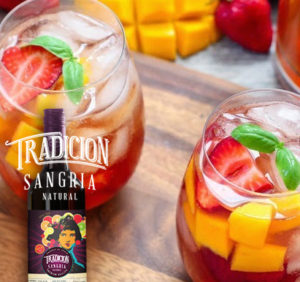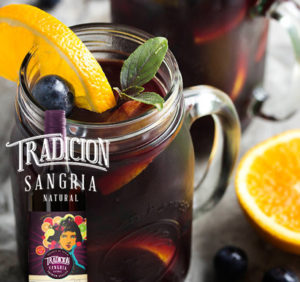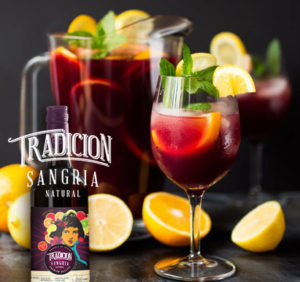N o v e d a d e s – S a n g r í a T r a d i c i ó n . c o m
Amaya Cervera. In 2013, and for the first time in history, Spain became the largest producer of wine in the world. An extremely abundant harvest – especially in La Mancha – and the reduced production in France and Italy, its closest rivals in the main wine league, were the main factors behind this wave. Many would say that the pleasant and sunny climate of Spain makes many comfortable armchair crops, but to my mind that is a rather simplistic view of a country that still boasts the largest surface of vineyard in the world.
Very few regions escape the cliché of dry and safe growing seasons. Take Ribera del Duero for example, where vegetative cycles are short and producers may have to deal with frost in both May and September. In the extreme northwest, and this is the Albariño country, the average annual rainfall is 1,600 mm, much higher than in Champagne or the Moselle. Under these humid conditions, oidio is a constant threat to Galician winemakers and harvests must be completed before high pressure from the Azores gives way to Atlantic storms and a sudden end to summer. In addition, the maturation of the grape can be a very challenging work in the northernmost areas of Navarre, Rioja, Leon or Catalonia.
At the other end of the scale, heat is not always welcome, especially when it exceeds 40 ° C. Such climate is quite common in large areas of the driest half of southern Spain such as La Mancha, Cordoba, Extremadura and Levante (Alicante, Jumilla …). In Catalonia, the thirsty vines of the Priorat (300 mm can be all the rain they receive in a year) have to dig their roots very deep in search of water and nutrients. Here, the combination of old vines, poor shale soils and extreme weather conditions give rise to concentrated, alcoholic but very distinctive reds. However, the powerful, highly extracted bombs that thrived in the 1990s are giving way to a more aromatic and balanced style with softer tannins and a good Mediterranean character.

Most winemakers aware of quality are particularly concerned with achieving balance in their wines. In Spain, that requires a perfect alcoholic integration and seeks freshness in hot and dry areas. Winemaking techniques include whole-berry fermentations, mixing with grapes harvested early, or using specific types of yeast aimed at reducing alcohol levels. The introduction of grape varieties with longer cycles has also been successful in hot regions, although producers rarely reveal their names, most of these varieties are not authorized by local regulatory councils or can only be cultivated experimentally. Take the Rioja Graciano. It moves south where it ripens very well and can add hearty and herbaceous notes to many animated wines. Further south, the Portuguese Trincadeira and Touriga Nacional are the best kept secrets behind the most exciting reds of Extremadura.
On the other hand, Spain is a mountainous country, with a vast plateau that covers a large area in the center, so that altitude can be a crucial quality factor. The plantation at higher altitudes ensures a greater maturation, bringing freshness and balance. Some of the most exciting wines launched in the last decade come from the high vineyards located in Bierzo, on the slopes of the Moncayo in Aragon or in the mountains of Gredos (Madrid, Ávila, Toledo) and Montsant (Tarragona).
In general, Spain can be the land of the sun, but when it comes to wine, diversity can be really striking. I firmly believe that the country can offer wines to match almost all palates. Where should you look to find the ones that best suit your taste? I have tried to draw a mental map that divides the main wine-growing regions of Spain – not necessarily the denominations – by style and type of wine. I hope this highly personal and fairly general outline can be used as a handy guide to tackle the shelves of your local wine store in a more relaxed way. Downloading the complete map of the Spanish wine regions compiled by Spanish wines will definitely help readers locate each region accurately.

Box office hits
Deeply colored reds, highly structured, high alcohol, with some good examples of fineness. These are the ones I like to call the mighty three and include: Ribera del Duero and its surroundings; Toro, whose wines tend to be heavier but with voluptuous textures while the alcohol is well integrated; And Priorat in Catalonia. I would like to add the seemingly unglamorous region of Almansa (Castilla La Mancha), because fans of potent wines will love the natural strength of the old strains of Garnacha Tintorera. On your own, Tintorera is a real beast!
Fineness
Rioja is still the place to go for fine red wines, capable of aging and full of complexity and nuances. From the historic Gran Reservas, which are again in the spotlight, new and recent companies exploring specific terroirs in the denomination. The only region that could compete for this honor, albeit more illusory than real, is Navarre, in particular, its central and northern areas.
Mediterranean world
There is something more magical about the way most good growers in this area are able to combine the fully ripe fruit with freshness. It happens with Monastrell in Alicante, Yecla and Jumilla; And with Garnacha (often accompanied by Carignan) in Catalonia. A character of Mediterranean scrub (pine nuts, rosemary and / or thyme) is able to counteract the relatively high content of alcohol. Many international grapes grown in the area can also be infused by this nice feature provided the yields are kept under control. The red ones of the Priorat that present a subtle aromatic style should definitely be included in this group.
The New World of Spain
This category includes the regions of international grape: Penedès in Catalonia, Somontano in Aragón, Navarre and some specific companies in Castilla La Mancha, Castilla y León, Extremadura or Andalusia. While such an approach may not seem very attractive at a time when local grapes are thriving, it certainly demonstrated its effectiveness in the production of quality wines in the 1990s. However, it is worth watching them, as some of these Regions have also begun to work with local grapes (Xarel.lo and Sumoll in Penedès, Grenache in Somontano) or refining their mixtures, as in the case of Navarre.

You say Grenache, I say Garnacha
It used to be the most widely planted red grape and now ranks fourth, but there have never been as many exciting Garnachas in the country as there is right now. The styles can vary significantly from one region to another: potent in Aragon (Campo de Borja, Calatayud, Cariñena), cooler and medium-bodied in Navarra (although most grapes are used to make rosés) and richer in Méntrida . The Garnachas of Gredos (part of Méntrida, inos of Madrid, Cebreros) are so meticulous minerals that I prefer to place them in the following category.
New and exciting flavors
This is the result of a better understanding of local grapes and terroirs. A new generation of young and brave oenologists and vignerons are shaking the Spanish vineyards. The recovery of old plots planted with native vineyards has led to a new, soft Burgundian approach in the winery. In fact, Pinot Noir seems to have more in common with the natural delicacy of many heritage varieties than the style of extract-as-it-may-be imposed by regions dominated by Tempranillo. Look for these new wines in wine regions such as the Canary Islands, Baleares, Gredos, Ribeira Sacra, Bierzo, Sierra de Salamanca, Tierra de León. The bad news is that most of them are made in small amounts, depending on the size of the vineyards that come.
White specialists
Directed by the strong character of Albariño and Verdejo, and thanks to an increasing demand of the international markets, the Spanish white wines have flourished in the last decade. Most white cultivated areas in Spain are closely related to a single grape variety whose name I have enclosed in parentheses. Rueda (Verdejo) in Castilla y León; Rías Baixas (Albariño), Valdeorras (Godello) and Ribeiro (Treixadura) in Galicia; Txakoli (Hondarrabi zuri) in the Basque Country; Terra Alta (Garnacha Blanca) in Catalonia; Albillo in different areas of Castile, and the best white of Rioja (mainly Viura with small percentages of Malvasia and Garnacha Blanca) that offer an increasing diversity of styles and they should not be despised.

Quantity on quality
This is sadly true for many producers in the great region of Castilla-La Mancha that covers different denominations (La Mancha, Valdepeñas, Mondéjar, Manchuela, Uclés, Ribera del Júcar and Almansa) and Extremadura. However, you will be able to find many exceptions to this rule, since some highly respected winemakers rely on these areas.
Sherry
This historic region in the south of Andalusia, together with Montilla-Moriles de Córdoba, should have a section of its own. Its wines are unique and traditional: Fino, Manzanilla (only in the sea, in Sanlúcar de Barrameda), Palo Cortado, Amontillado and Oloroso.





Comments are closed.